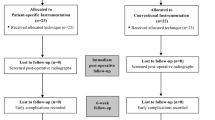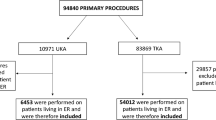Abstract
Background
Implant malpositioning, low surgical caseload, and improper patient selection have been identified as essential factors, which could negatively affect the longevity of unicompartmental knee arthroplasty (UKA). The aim of the current study was to evaluate the impact of the surgeon’s caseload on patient selection, component positioning, as well as component survivorship and functional outcomes following a PSI-UKA.
Methods
A total of 125 patient-specific instrumented (PSI) UKA were included. One hundred and two cases were treated by a high-volume surgeon (usage 40%) and 23 cases by a low-volume surgeon (< 10 cases/year, usage 34%). Preoperative UIS, as well as the postoperative clinical and radiologic outcome, were assessed retrospectively.
Results
Irrespective of the surgeon’s UKA caseload, PSI allowed good accuracy in component positioning (p > 0.05). The high-volume surgeon had a more strict indication for UKA with 89% showing a UIS > 25 (considered a good indication) compared to 70% for the low-volume surgeon (p = 0.016). The low-volume surgeon achieved worse results regarding functional outcome (p < 0.05) and a tendency toward an increased risk for UKA failure (p = 0.11) compared to the high-volume surgeon.
Conclusion
Due to potential selection errors, mostly connected to a low UKA-caseload, low-volume UKA surgeons might achieve worse outcomes. Very strict indications for UKA might be recommended in low-volume surgeons to achieve excellent clinical outcomes following a UKA.


Similar content being viewed by others
References
Ackroyd CE (2003) Medial compartment arthroplasty of the knee. J Bone Joint Surg Br 85(7):937–942
Patil S, Colwell CW Jr, Ezzet KA, D'Lima DD (2005) Can normal knee kinematics be restored with unicompartmental knee replacement? J Bone Joint Surg Am 87(2):332–338
Hauer G, Sadoghi P, Bernhardt GA, Wolf M, Ruckenstuhl P, Fink A et al (2020) Greater activity, better range of motion and higher quality of life following unicompartmental knee arthroplasty: a comparative case-control study. Arch Orthop Trauma Surg 140(2):231–237
Morris MJ, Molli RG, Berend KR, Lombardi AV Jr (2013) Mortality and perioperative complications after unicompartmental knee arthroplasty. Knee 20(3):218–220
Berger RA, Meneghini RM, Jacobs JJ, Sheinkop MB, Della Valle CJ, Rosenberg AG et al (2005) Results of unicompartmental knee arthroplasty at a minimum of ten years of follow-up. J Bone Joint Surg Am 87(5):999–1006
Newman J, Pydisetty RV, Ackroyd C (2009) Unicompartmental or total knee replacement: the 15-year results of a prospective randomised controlled trial. J Bone Joint Surg Br 91(1):52–57
Hernigou P, Deschamps G (2004) Posterior slope of the tibial implant and the outcome of unicompartmental knee arthroplasty. J Bone Joint Surg Am 86(3):506–511
Hernigou P, Deschamps G (2004) Alignment influences wear in the knee after medial unicompartmental arthroplasty. Clin Orthop Relat Res 423:161–165
Epinette JA, Brunschweiler B, Mertl P, Mole D, Cazenave A (2012) Unicompartmental knee arthroplasty modes of failure: wear is not the main reason for failure: a multicentre study of 418 failed knees. Orthop Traumatol Surg Res OTSR 98(6 Suppl):S124–S130
Diezi C, Wirth S, Meyer DC, Koch PP (2010) Effect of femoral to tibial varus mismatch on the contact area of unicondylar knee prostheses. Knee 17(5):350–355
Liddle AD, Pandit H, Judge A, Murray DW (2016) Effect of surgical caseload on revision rate following total and unicompartmental knee replacement. J Bone Joint Surg Am 98(1):1–8
Vasso M, Antoniadis A, Helmy N (2018) Update on unicompartmental knee arthroplasty: current indications and failure modes. EFORT Open Rev 3(8):442–448
Flury A, Hasler J, Dimitriou D, Antoniadis A, Finsterwald M, Helmy N (2019) Midterm clinical and radiographic outcomes of 115 consecutive patient-specific unicompartmental knee arthroplasties. Knee 26(4):889–896
Dao Trong ML, Diezi C, Goerres G, Helmy N (2015) Improved positioning of the tibial component in unicompartmental knee arthroplasty with patient-specific cutting blocks. Knee Surg Sports Traumatol Arthrosc 23(7):1993–1998
Jones GG, Logishetty K, Clarke S, Collins R, Jaere M, Harris S et al (2018) Do patient-specific instruments (PSI) for UKA allow non-expert surgeons to achieve the same saw cut accuracy as expert surgeons? Arch Orthop Trauma Surg 138(11):1601–1608
Liddle AD, Pandit H, Judge A, Murray DW (2015) Optimal usage of unicompartmental knee arthroplasty: a study of 41,986 cases from the National Joint Registry for England and Wales. Bone Joint J 97-b(11):1506–1511
Antoniadis A, Dimitriou D, Canciani JP, Helmy N (2019) A novel preoperative scoring system for the indication of unicompartmental knee arthroplasty, as predictor of clinical outcome and satisfaction. Arch Orthop Trauma Surg 139(1):113–120
Hamilton TW, Rizkalla JM, Kontochristos L, Marks BE, Mellon SJ, Dodd CAF et al (2017) The interaction of caseload and usage in determining outcomes of unicompartmental knee arthroplasty: a meta-analysis. J Arthroplast 32(10):3228–37.e2
Vasso M, Del Regno C, D'Amelio A, Viggiano D, Corona K, Schiavone PA (2015) Minor varus alignment provides better results than neutral alignment in medial UKA. Knee 22(2):117–121
Deschamps G, Chol C (2011) Fixed-bearing unicompartmental knee arthroplasty patients’ selection and operative technique. Orthop Traumatol Surg Res 97(6):648–661
Matziolis G, Mueller T, Layher F, Wagner A (2018) The femoral component alignment resulting from spacer block technique is not worse than after intramedullary guided technique in medial unicompartimental knee arthroplasty. Arch Orthop Trauma Surg 138(6):865–870
Kellgren JH, Lawrence JS (1957) Radiological assessment of osteo-arthrosis. Ann Rheum Dis 16(4):494–502
Altman RD, Fries JF, Bloch DA, Carstens J, Cooke TD, Genant H et al (1987) Radiographic assessment of progression in osteoarthritis. Arthritis Rheum 30(11):1214–1225
Kozinn SC, Scott R (1989) Unicondylar knee arthroplasty. J Bone Joint Surg Am 71(1):145–150
Dejour H, Bonnin M (1994) Tibial translation after anterior cruciate ligament rupture two radiological tests compared. J Bone Joint Surg Br 76(5):745–749
Kerens B, Leenders AM, Schotanus MGM (2018) Patient-specific instrumentation in Oxford unicompartmental knee arthroplasty is reliable and accurate except for the tibial rotation. Knee Surg Sports Traumatol Arthrosc 26(6):1823–1830
Campi S, Pandit HG, Dodd CAF, Murray DW (2017) Cementless fixation in medial unicompartmental knee arthroplasty: a systematic review. Knee Surg Sports Traumatol Arthrosc 25(3):736–745
van der List JP, Zuiderbaan HA, Pearle AD (2016) Why do medial unicompartmental knee arthroplasties fail today? J Arthroplast 31(5):1016–1021
Bell SW, Stoddard J, Bennett C, London NJ (2014) Accuracy and early outcomes in medial unicompartmental knee arthroplasty performed using patient specific instrumentation. Knee 21(Suppl 1):S33–S36
Pearle AD, van der List JP, Lee L, Coon TM, Borus TA, Roche MW (2017) Survivorship and patient satisfaction of robotic-assisted medial unicompartmental knee arthroplasty at a minimum two-year follow-up. Knee 24(2):419–428
Alvand A, Khan T, Jenkins C, Rees JL, Jackson WF, Dodd CAF et al (2018) The impact of patient-specific instrumentation on unicompartmental knee arthroplasty: a prospective randomised controlled study. Knee Surg Sports Traumatol Arthrosc 26(6):1662–1670
Antoniadis A, Camenzind RS, Schar MO, Bergadano D, Helmy N (2019) Accuracy of tibial cuts with patient-specific instrumentation is not influenced by the surgeon’s level of experience. Knee Surg Sports Traumatol Arthrosc 27(5):1535–1543
Funding
There is no external funding source, or the funding source did not play a role in the investigation.
Author information
Authors and Affiliations
Corresponding author
Ethics declarations
Conflict of interest
The author(s) declared that they have no conflict of interest.
Additional information
Publisher's Note
Springer Nature remains neutral with regard to jurisdictional claims in published maps and institutional affiliations.
Rights and permissions
About this article
Cite this article
Schraknepper, J., Dimitriou, D., Helmy, N. et al. Influence of patient selection, component positioning and surgeon’s caseload on the outcome of unicompartmental knee arthroplasty. Arch Orthop Trauma Surg 140, 807–813 (2020). https://doi.org/10.1007/s00402-020-03413-7
Received:
Published:
Issue Date:
DOI: https://doi.org/10.1007/s00402-020-03413-7




